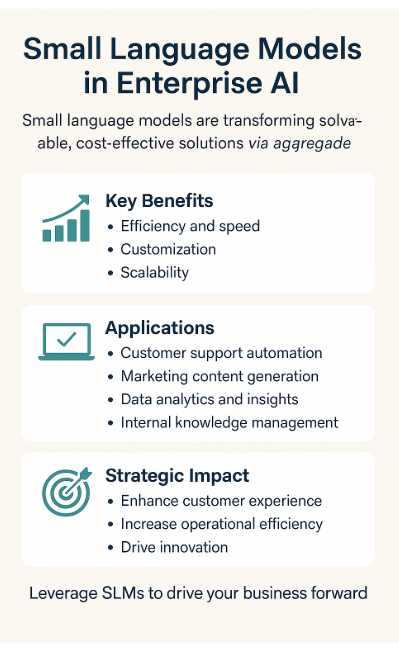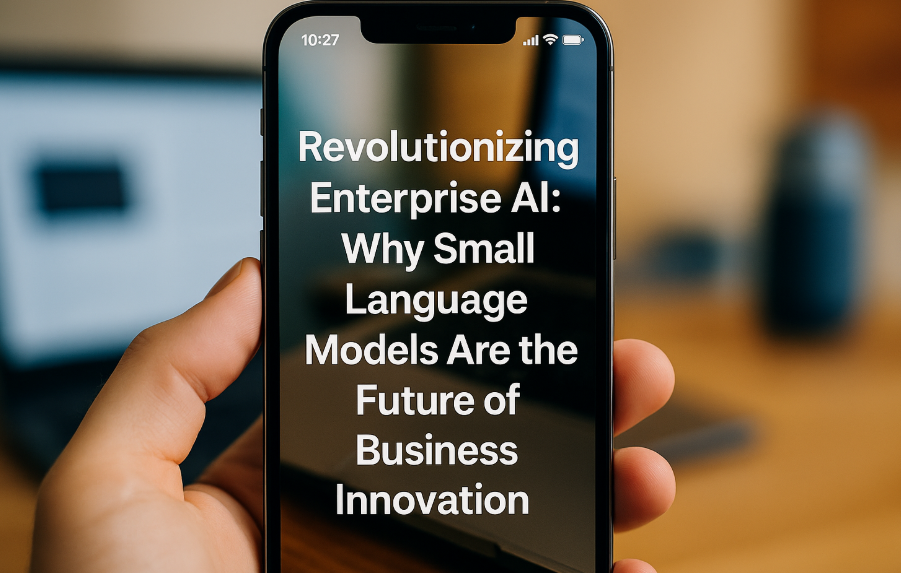As enterprise leaders increasingly turn to artificial intelligence (AI) to drive innovation and productivity, there’s been a noticeable shift toward smaller, more efficient AI models. These are known as small language models (SLMs) compact but powerful systems that are changing the way businesses operate.
Unlike their heavyweight counterparts such as GPT-4, SLMs are specifically engineered to handle domain-specific tasks with greater efficiency, lower resource consumption, and faster deployment. This post breaks down what small language models are, why they matter, and how your organization can leverage them for a strategic AI edge.
What Are Small Language Models?
Small language models are AI systems built to understand, generate, and analyze natural language just like their larger versions. However, their key distinction lies in their specialization. SLMs are fine-tuned to perform highly specific enterprise functions, making them more lightweight, faster to deploy, and easier to integrate into business environments.
Unlike general-purpose models, SLMs are optimized for tasks such as:
-
Summarizing documents
-
Generating responses in chatbots
-
Extracting sentiment from text
-
Providing tailored insights for business units
The Strategic Advantages of Small Language Models
Organizations are turning to SLMs because they offer compelling business value:
1. Efficiency and Speed
Smaller models are leaner and computationally efficient, allowing businesses to deploy them in environments where larger models would be cost-prohibitive.
2. Customization
SLMs can be trained or fine-tuned on domain-specific datasets, improving their performance in niche areas like legal compliance, finance, or customer support.
3. Scalability
Because of their smaller footprint, SLMs are easy to scale across multiple departments or regions without incurring high infrastructure costs.

4. Security and Privacy
In regulated industries, SLMs can be deployed on-premises, ensuring sensitive data doesn’t leave the enterprise ecosystem something not always possible with massive cloud-based models.
Real-World Applications in Enterprise Settings
Businesses across industries are already seeing transformational results by adopting SLMs in areas such as:
• Customer Support Automation
Companies use SLMs to power intelligent chatbots and virtual agents capable of resolving customer queries in real-time while escalating only the complex cases to human agents.
• Marketing and Content Creation
Marketing teams are leveraging SLMs to generate content, automate social media messaging, tailor product descriptions, and create email campaigns all with contextual accuracy.
• Data Analytics and Business Intelligence
By analyzing structured and unstructured data, SLMs surface insights that help in decision-making, trend prediction, and risk assessment.
• Internal Knowledge Management
SLMs help employees query company policies, HR information, or technical documentation using natural language, improving internal productivity.
Looking Ahead: The Role of SLMs in the AI-Driven Enterprise
As we approach the next frontier of AI integration, SLMs are not just a trend they are a blueprint for sustainable innovation.
They promise to:
-
Reduce dependency on large, generalized AI tools
-
Enable faster experimentation and iteration
-
Support agile deployments in startups, SMBs, and large enterprises alike
-
Allow hybrid AI environments that mix local deployments and cloud AI for optimal control
The business case for adopting SLMs is no longer just about cost savings it’s about staying competitive in a market increasingly defined by speed, personalization, and smart automation.
What This Means for You
Whether you’re leading an enterprise AI team or exploring automation for the first time, here’s how SLMs can advance your organization:
Enhance Customer Experience
Deliver instant, accurate, and personalized responses to customer interactions building loyalty and satisfaction at scale.
Increase Operational Efficiency
Automate high-frequency tasks such as report generation, trend summarization, and ticket categorization freeing up human teams for high-impact work.
Accelerate Time to Market
Use SLMs to prototype AI solutions quickly, enabling agile rollouts of AI products and services.
Drive Innovation Across Departments
From finance to HR to sales, SLMs unlock new automation opportunities, enabling data-driven insights that power strategic moves.
Final Thoughts: Why It’s Time to Adopt Small Language Models
Small language models are poised to reshape the enterprise AI landscape. Their lightweight nature, faster training cycles, and high adaptability make them a perfect fit for modern businesses looking to scale AI responsibly without overspending.
Organizations that embrace this shift early will gain a competitive edge not just by reducing costs but by reimagining what’s possible with enterprise AI.
So ask yourself: Is your AI strategy still tied to “big is better”? Or are you ready to scale smarter, not larger?







